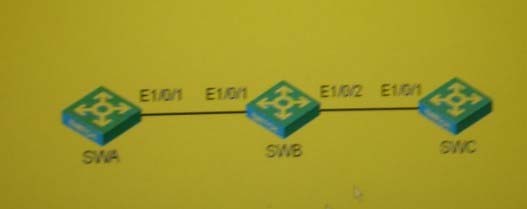- All Exams Instant Download
In the switching network as shown in the figure, all three switches only have the default VLAN1, the interconnection ports of the three switches are trunks, and all VLANs are allowed to pass, and the three switches have the global and port GVRP functions enabled. VLAN10 is created on the switch SVVA, and VLAN20 is created on the switch SWC. Check the status information of each Trunk port on the three switches. The correct one is displayed below
In the switching network as shown in the figure, all three switches only have the default VLAN1, the interconnection ports of the three switches are trunks, and all VLANs are allowed to pass, and the three switches have the global and port GVRP functions enabled. VLAN10 is created on the switch SVVA, and VLAN20 is created on the switch SWC. Check the status information of each Trunk port on the three switches. The correct one is displayed below

A . [SWA]display interface Ethernet 1/0/1
Ethernet1/0/1 current state: UP ……
PVID: 1
Mdi type: auto
Link delay is 0(sec)
Port link-type: trunk
VLAN passing: 1 (default vlan), 10,20
VLAN permitted: 1 (default vlan), 2-4094
Trunk port encapsulation: IEEE 802.1q
B . [SWB]display interface Ethernet 1/0/1
Ethernet1/0/1 current state: UP ……
PVID: 1
Mdi type: auto
Link delay is 0(sec)
Port link-type: trunk
VLAN passing: 1 (default vlan), 10,20
VLAN permitted: 1 (default vlan), 2-4094
Trunk port encapsulation: IEEE 802.1q
C . [SWB]display interface Ethernet 1/0/2
Ethernet1/0/2 current state: UP ……
PVID: 1
Mdi type: auto
Link delay is 0(sec)
Port link-type: trunk
VLAN passing: 1 (default vlan), 10,20
VLAN permitted: 1 (default vlan), 2-4094
Trunk port encapsulation: IEEE 802.1q
D . [SWC]display interface Ethernet 1/0/1
Ethernet1/0/1 current state: UP ……
PVID: 1
Mdi type: auto
Link delay is 0(sec)
Port link-type: trunk
VLAN passing: 1 (default vlan), 10,20
VLAN permitted: 1 (default vlan), 2-4094
Trunk port encapsulation: IEEE 802.1q
Answer: AD
Latest GB0-371-ENU Dumps Valid Version with 341 Q&As
Latest And Valid Q&A | Instant Download | Once Fail, Full Refund
Subscribe
Login
0 Comments
Inline Feedbacks
View all comments

